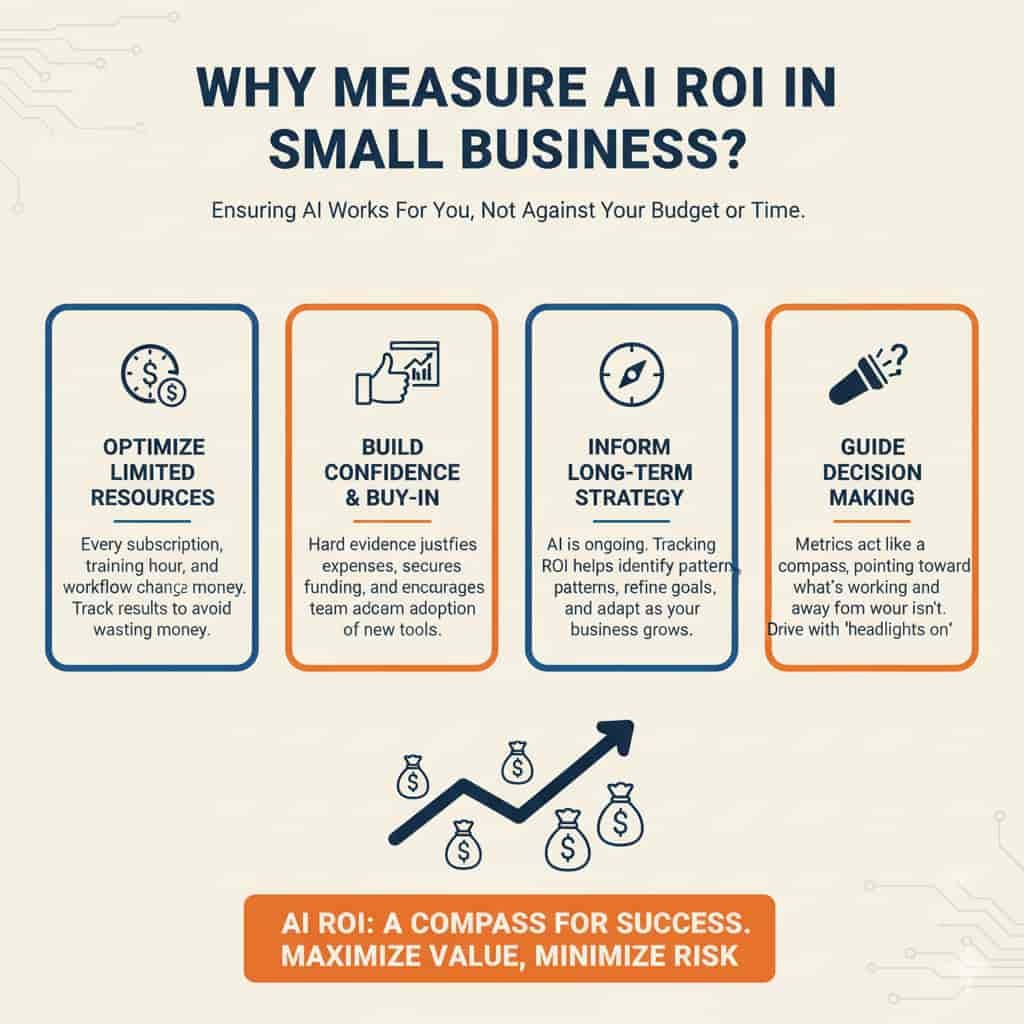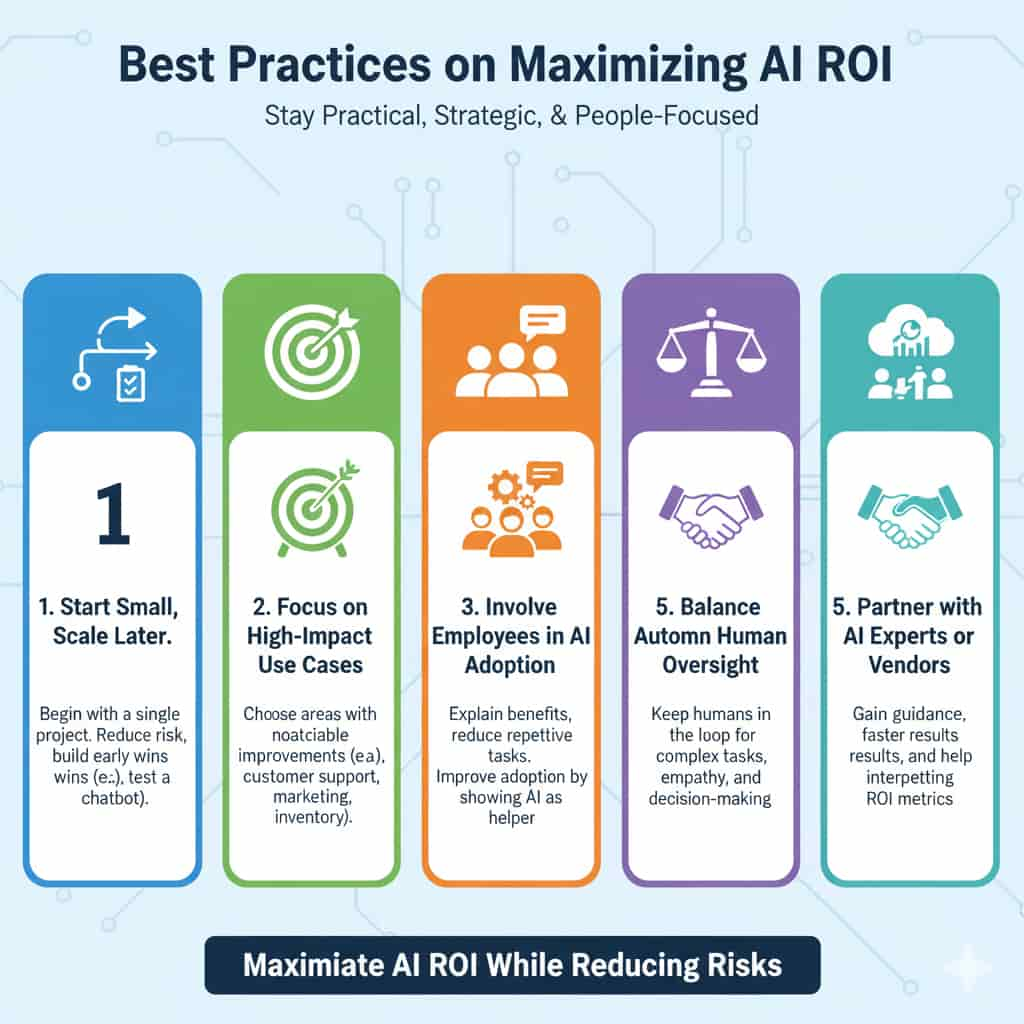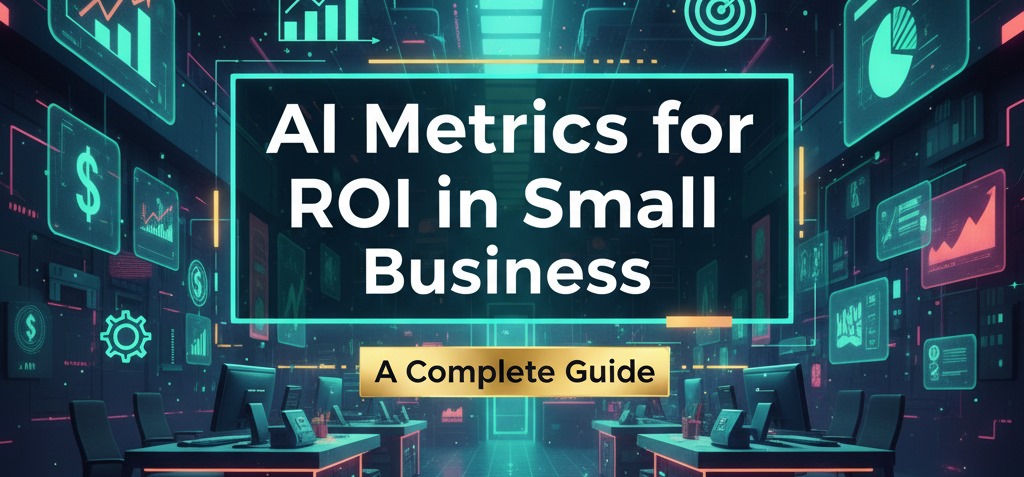Introduction
These days, artificial intelligence isn’t limited to tech companies. AI Metrics can now be used by small businesses to increase sales, save costs, and satisfy customers. The catch is that measuring results is essential to success. AI metrics for ROI can help with that. Let’s take a straightforward and useful approach.
What is ROI in Small Business?
One of the most crucial metrics in business is return on investment, or ROI. It lets you know if the money you’re spending is truly making a difference. Fundamentally, ROI weighs the costs and benefits of an investment. You’re on the right track if the return outweighs the expense.
ROI is a survival tool for small businesses, not just a financial formula. Every dollar must be used wisely because budgets and resources are scarce. For this reason, monitoring ROI aids in making more informed choices. You have evidence, so you don’t have to guess what’s working.
Consider investing $1,000 in an email marketing tool that uses artificial intelligence. The return on investment is obvious and favorable if it generates $3,000 in new sales.
However, the tool might not be worth keeping if its expenses exceed its profits.
To put it briefly, ROI aids small businesses in assessing value, reducing waste, and concentrating on the factors that actually propel growth. ROI, when applied to AI, indicates whether the technology is more than just a catchphrase and whether it produces meaningful outcomes.
What Are AI Metrics?
The figures and measurements used to monitor the effectiveness of artificial intelligence tools in your company are known as AI metrics. Consider them as a scoreboard that indicates whether AI Metrics is contributing to your success or failure.
AI metrics concentrate on particular results associated with AI Metrics use, as opposed to general ROI, which gauges overall success. These may include reduced expenses due to automation, increased revenue from tailored suggestions, or quicker reaction times from chatbots.
The important thing is that AI metrics are not only technical but also useful. To use them, you don’t have to be a data scientist. For instance, comparing customer satisfaction ratings before and after utilizing an AI Metrics chatbot can show whether or not service is truly getting better.
Certain AI metrics, such as revenue growth or customer lifetime value, are comparable to conventional business metrics. Others, like time-to-value the speed at which results are observed following adoption are specific to AI Metrics.
Small businesses can distinguish between hype and reality by monitoring AI metrics. You will understand precisely how AI affects your bottom line rather than wondering if it “works.” With the help of these insights, you can more easily defend investments, modify your approach, and maximize the benefits of any AI tool you select.
Why Measure AI ROI in Small Business?
AI can be both thrilling and intimidating. It’s simple to jump in without a plan when there are so many tools that promise automation, better decision making, and increased sales. The issue? Not all AI Metrics solutions are equally beneficial. This is the reason ROI measurement is so crucial.
Resources are scarce for small businesses. There are fees associated with each subscription, training session, and workflow modification. You may be wasting money without even realizing it if you’re not tracking results. Like a compass, ROI metrics guide you toward what is effective and away from what isn’t.
Confidence is also increased by measuring AI Metrics ROI. You have concrete proof that AI is worthwhile, so you don’t have to rely on your intuition. This facilitates securing funding, gaining team support, and justifying expenses. When workers see evidence that AI improves performance or lessens workload, they are more likely to adopt it.
Long term strategy is another factor. Adoption of AI is a continuous process rather than a one-time occurrence. You can spot trends, hone objectives, and adjust as your company expands by monitoring ROI. It would be like driving in the dark without headlights if there were no measurement.
To put it briefly, calculating AI ROI guarantees that AI benefits you rather than detracts from your time or money.

Key AI Metrics for Measuring ROI
1. Cost Savings
Cutting costs is one of the most obvious indicators of AI’s success. Automation tools can eliminate repetitive tasks, streamline operations, and reduce labor costs. For instance, an AI chatbot could take the place of a full time support agent in the evenings. Comparing costs before and after AI adoption is necessary to measure cost savings. You can determine the precise dollar amounts saved if payroll declines or fewer mistakes are made.
2. Revenue Growth
AI often drives sales through personalization and smarter targeting. For instance, recommendation engines suggest products that increase average order value. Tracking revenue growth linked to AI campaigns helps show if the technology is adding new income streams. Look at sales data before and after AI integration, and isolate campaigns influenced by AI driven insights.
3. Customer Acquisition Cost (CAC)
CAC measures how much it costs to acquire a new customer. AI can optimize ad spending, improve targeting, and lower the price of gaining each lead. By tracking CAC, businesses see whether AI marketing tools are truly efficient. If the cost per new customer decreases, ROI is on the rise.
4. Customer Lifetime Value (CLV)
CLV estimates how much revenue a customer brings over their entire relationship with your business. AI helps by personalizing offers, improving retention, and predicting behavior. For example, an AI driven loyalty program might increase repeat purchases. If CLV rises after AI adoption, that’s a clear ROI indicator.
5. Lead Conversion Rate
AI tools can nurture leads through smarter communication. Chatbots, email automation, and predictive scoring help convert prospects into paying customers. Tracking conversion rates shows whether AI is making the sales process more effective. Even a small percentage increase can add significant revenue over time.
6. Employee Productivity
AI doesn’t replace employees it enhances them. By automating repetitive tasks, AI frees staff to focus on higher-value work.
Productivity can be measured through output per employee, task completion time, or error reduction. If employees accomplish more in less time, the ROI is evident.
7. Customer Satisfaction & Retention
Happy customers stick around, and AI plays a role here too. Tools like AI powered chat support or personalized recommendations improve experiences. Tracking satisfaction scores, reviews, or repeat purchase rates reveals the impact. If retention rates increase, AI is paying off.
8. Time-to-Value
This indicator assesses how rapidly AI produces outcomes following deployment. Long wait times are unaffordable for small businesses. An AI tool is worth the investment if it yields quantifiable results in a matter of weeks or months. Keep track of the period between adoption and the first favorable result, like reduced expenses or increased sales.
These metrics work together to give a complete picture of AI ROI. While some emphasize long-term growth like CLV, others highlight short term gains like lower costs. Small businesses can increase value and make better decisions by concentrating on the proper mix.
How to Track AI ROI Effectively
1. Define Clear Business Goals
AI should serve your business, not the other way around. Start by setting specific goals. Do you want to cut customer support costs? Boost online sales? Improve marketing efficiency? Defining goals makes it easier to choose metrics that matter. Without clear targets, ROI tracking becomes guesswork.
2. Choose the Right AI Tools
Not all AI tools are created equal. Pick ones that align with your goals. For example, if customer service is your focus, invest in chatbots or sentiment analysis tools. If marketing is the goal, look for AI driven ad optimization. Avoid chasing trends choose tools that solve real business problems.
3. Set Baseline Metrics Before AI Implementation
You can’t measure improvement without knowing where you started. Record current numbers like average customer response time, monthly revenue, or employee hours spent on tasks before AI adoption. These baselines act as benchmarks to compare against future performance.
4. Use Dashboards and Analytics Platforms
Tracking metrics manually can be overwhelming. Use dashboards or built-in analytics from AI tools. Many platforms offer visual reports that highlight performance changes. For example, a CRM with AI features might show how lead conversion rates shift after automation.
5. Monitor Short-Term and Long-Term Impact
Some AI tools deliver quick wins, like reducing email response time. Others take longer to show benefits, such as customer lifetime value improvements. Track both short and long-term results to get the full ROI picture. Don’t dismiss AI too early if it needs time to mature.
6. Regularly Review and Adjust Strategy
AI is not a “set it and forget it” solution. Tools remain in line with business objectives thanks to routine check ins. If an AI platform isn’t producing the desired results, modify your approach by changing its application, offering additional training, or moving to a better alternative. When companies remain adaptable and proactive, ROI increases.
Preparation, tools, and continuous review are all necessary for effective tracking. Small businesses can use the insights to make better decisions and measure AI ROI with confidence by following these steps.
Benefits of Tracking AI ROI
Monitoring AI ROI changes a company’s operations, it’s not just about the numbers.
It aids in accountability, to start. You know exactly where your money goes and whether it’s working, so you don’t have to spend it carelessly. This prevents resource waste and boosts decision making confidence.
Second, opportunities are revealed by ROI tracking. You can reduce underperformers and increase your focus on winners by examining which AI tools provide the most value. This increases the efficiency and intelligence of future investments.
Third, tracking promotes development. You can scale those solutions to other parts of the business once you know which tools increase customer satisfaction, save time, or increase sales.
Lastly, ROI tracking fosters confidence. Workers observe proof that AI simplifies their work. Consumers have better experiences. Stakeholders receive evidence that their investments are profitable.
To put it briefly, tracking AI ROI is about more than just financial savings; it’s about gaining confidence, growth, and long-term success.
Read more: AI Automation ROI: 5 Business Cases That Deliver Massive …
Challenges in Measuring AI ROI for Small Businesses
1. Limited Budgets and Resources
Small business concern don’t always have the funds for advanced analytics tools or dedicated staff. This can make tracking ROI harder. The mixture is to beginning small with affordable or free platforms and focus only on the most impactful metrics.
2. Data Quality Issues
AI depends on close data. If customer records are outdated or inconsistent, results may be unreliable. Businesses must invest time in cleansing and organizing data before expecting accurate ROI reference point.
3. Lack of Technical Expertise
Without in-house expertise, small business organization may struggle to interpret results. Partnering with vendors, hiring consultants, or using user-friendly horizontal surface can bridge the gap.
4. Difficulty Linking AI Directly to Profitability
AI’s impact is old indirect. For example, a chatbot might improve customer satisfaction but not immediately increase sales. Measuring ROI requires patience and creativeness in connecting dots between AI use and overall profitability.
Despite these challenges, tracking ROI is possible with the right mindset and tools. Awareness of these obstruction helps businesses prepare solutions ahead of time.
Read more: The BEST $0→$10k/Month AI Business For Beginners in 2025
Best Practices for Maximizing AI ROI
1. Start Small, Scale Later
Begin with a single project instead of overhauling everything at once. For example, test an AI chatbot before spread out to marketing mechanization. This reduces risk and builds early wins.
2. Focus on High-Impact Use Cases
Choose areas where AI can deliver the most noticeable improvements. Customer support, marketing, and inventory management often provide fast, measurable returns.
3. Involve Employees in AI Adoption
Worker may resist AI if they fear it will replace them. Involve them early, say benefits, and show how AI reduces repetitive tasks. When employees see AI as a helper, adoption improves.
4. Balance Automation with Human Oversight
AI is powerful, but it’s not perfect. Keep human race in the loop for complex tasks, decision-making, or case action that require empathy. This equilibrium ensures quality and avoids mistakes.
5. Partner with AI Experts or Vendors
Small business concern concern don’t need to figure everything out alone. Partnering with AI vendors, consultants, or industry experts provides guidance and faster results. These partnerships can also help interpret ROI metrics overmuch effectively.
By following these best practices, businesses can maximize AI ROI while reducing risks. The key is to stay practical, strategic, and people focused.

Real-World Examples of AI ROI in Small Business
- Local Retail Store: A boutique clothing shop used AI powered recommendations on its online store. Within three months, average order value increased by 20%. ROI came from higher sales per customer.
- Café and Restaurant: A small café implemented an AI scheduling tool to optimize staff shifts. Labor costs dropped by 15% without affecting service quality. The savings paid for the tool in less than two months.
- Digital Marketing Agency: A small agency adopted AI for ad targeting. Campaign efficiency improved, cutting customer acquisition costs by 25%. This boosted profit margins and attracted more clients.
- Home Services Business: A plumbing company added an AI chatbot to its website. The bot handled after hours inquiries, booking jobs automatically. This increased conversions by 18% while reducing missed calls.
- Health & Wellness Studio: A yoga studio used AI for personalized email campaigns. Retention rates improved, with members attending more sessions and renewing memberships. Customer lifetime value increased significantly.
These illustrations demonstrate that AI ROI is not exclusive to tech-heavy sectors. Adoption of AI can be measured and advantageous for any small business, from neighborhood stores to service providers.
Read more: Why AI Automation Projects Fail to Scale 2025
Frequently Asked Questions
1. What’s the easiest AI tool for small business ROI tracking?
AI-powered dashboards or analytics tools, such as those built into CRMs or marketing platforms, are the easiest starting point. They require little setup and give clear reports on performance.
2. How long does it take to see ROI from AI?
It depends on the tool. Some deliver results within weeks, like chatbots or ad optimizers. Others, such as AI-driven customer loyalty systems, may take months before showing measurable returns.
3. Do small businesses need a data team to measure AI ROI?
Not necessarily. Many AI tools are designed for non technical users. While a data team can help with advanced tracking, most small businesses can rely on built in analytics and vendor support.
4. Can AI improve customer retention for local businesses?
Yes. AI can personalize offers, send reminders, and track customer behavior. Local businesses like salons or gyms benefit by keeping customers engaged and loyal.
5. How do I know if AI is saving me money?
Compare costs before and after implementation. Look for reduced labor hours, fewer errors, or lower ad spending. If expenses drop without hurting quality, AI is saving you money.
6. What’s the difference between ROI metrics and KPIs in AI?
ROI metrics measure financial return, while KPIs measure broader performance goals. For example, customer satisfaction is a KPI, but when linked to repeat purchases, it becomes part of ROI.
7. Are free AI tools reliable for ROI measurement?
Free tools can be useful for starting out, but they often have limitations. Paid platforms usually offer more accurate analytics, support, and scalability.
8. How can I compare AI ROI with traditional marketing ROI?
Measure both using the same formulas. For example, calculate customer acquisition cost or revenue growth from AI campaigns versus traditional ads. This shows which approach is more cost-effective.
9. What industries benefit most from AI ROI tracking?
Almost all industries benefit, but retail, services, marketing, and hospitality often see faster returns because of customer focused use cases.
10. Is AI ROI different for service based vs. product based businesses?
Yes. Product businesses often focus on sales growth and inventory savings, while service businesses track productivity, customer retention, and scheduling efficiency. Both can benefit, but the metrics differ slightly.


1 thought on “AI Metrics for ROI in Small Business: Best Guide 2025”